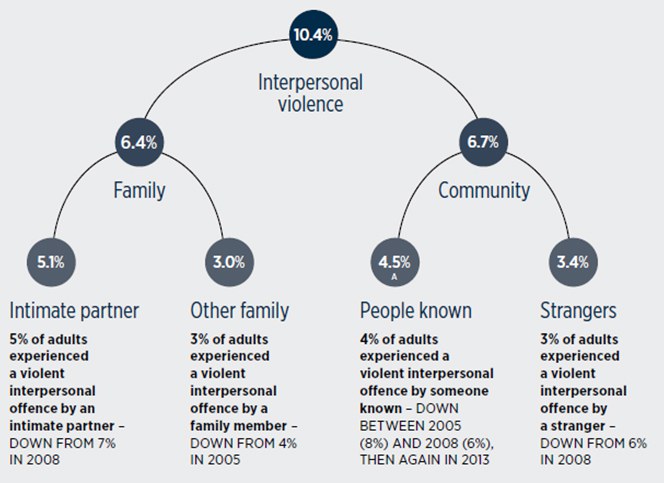Interpersonal violence
This page answers the questions:
- What is interpersonal violence?
- Has the amount of interpersonal violence changed over time?
- How do victims of interpersonal violence know their offenders?
- What types of interpersonal violence do victims experience?
- How many violent interpersonal offences are reported to the Police?
- How often are weapons used in interpersonal violence?
- How often is alcohol or drugs a factor in interpersonal violence?
What is interpersonal violence?
We look at interpersonal violence in two ways:
- by the victim’s relationship to the offender
- by the type of offences committed
When victims knew who had committed the offence, the NZCASS asked what their relationship was to the offender at the time of the offence. From this information we can look at victimisation by different types of relationship:
- violence by family (including intimate partners)
- violence by family (excluding intimate partners)
- violence by intimate partners (current and ex-partners)
- violence by community (people who aren’t a family member or intimate partner)
- violence by people known (excluding intimate partners or family members)
- violence by strangers.
In the 2014 NZCASS, ‘violent interpersonal offences’ included three main offence groupings:
- physical offences (including assault, abduction/kidnapping and robbery)
- sexual offences (including sexual violation and indecent assault)
- threats and damage offences (including threats and damage to personal or household property).
See Interpersonal violence defined for more information.
Has the amount of interpersonal violence changed over time?
While there were no changes between 2005 and 2008, all violent interpersonal offence measures fell between 2008 and 2013:
- The total number of offences fell by 23%, down from 1,794,000 in 2008 to 1,379,000 in 2013
- The total number of adults victimised once or more fell by 29%, down from 530,000 in 2008 to 376,000 in 2013
- The percentage of adults victimised once or more fell 5 percentage points, down from 15% in 2008 to 10% in 2013
- The average number of violent interpersonal offences per 100 adults fell by 14 offences, down from 52 offences per 100 adults in 2008 to 38 offences in 2013.
While the number of violent interpersonal offences fell between 2008 and 2013, the percentage of violent interpersonal offences, compared to non-violent crime, increased to 67% in 2013 (up from 59% in 2008).
How do victims of interpersonal violence know their offenders?
When we looked at the number of violent interpersonal offences by the victim’s relationship to the offender in 2013, we found that:
- 781,000 violent interpersonal offences were committed by a family member (including intimate partners and other family members)
- 491,000 violent interpersonal offences were committed by an intimate partner
- 258,000 violent interpersonal offences were committed by someone who was family (but wasn’t an intimate partner)
- 367,000 violent interpersonal offences were committed by someone known to the victim (but not an intimate partner or family member)
- 190,000 violent interpersonal offences were committed by strangers.
We also looked at the percentage of adults who were victims of one or more violent interpersonal offences in 2013 by the victim’s relationship to the offender. See the diagram below for the figures.

A. Rounds to 4% from unrounded numbers.
|
Supporting information You can’t add together the different relationship groups in the diagram because:
|
What types of interpersonal violence do victims experience?
As well as looking at the victim’s relationship to the offender, we also looked at the type of interpersonal violence they experienced.
When looking at the different types of violent interpersonal offences experienced in 2013, we found:
- 7% of adults were the victim of one or more threat or damage offences, down from 10% in 2008
- 6% of adults were the victim of one or more physical offences, down from 9% in 2008
- 2% of adults were the victim of one or more sexual offences, down from 3% in 2008.
See our Sexual violence webpage for more information about sexual offences.
We also looked at the percentage of people who experienced more than one type of these violent interpersonal offences, and found that in 2013 1% of adults experienced all three types of interpersonal violence (threats and damage, physical, and sexual).
Types of interpersonal violence by the victim’s relationship to the offender
We analysed the different offender relationships within the three types of violent interpersonal offences in 2013. We found that:
- 3% of adults were the victim of one or more threat or damage offences by an intimate partner, down from 5% in 2008
- 3% of adults were the victim of one or more physical offences by an intimate partner, down from 5% in 2008
- 1% of adults were the victim of one or more sexual offences where they knew the offender (but the offender was not a family member or intimate partner), down from 3% in 2005.
Interpersonal violence by intimate partners
When looking at interpersonal violence committed by intimate partners, we found that women (6%) were more likely than men (4%) to be the victim of a violent interpersonal offence by an intimate partner in 2013.
We looked at whether men and women experienced intimate partner violence differently. We found that in 2013:
- women (1.6%) were more likely than men (0.5%) to have experienced one or more sexual offences by an intimate partner
- there were no statistically significant differences between men and women in their experience of physical offences or threats and damage offences by an intimate partner.
How many violent interpersonal offences are reported to the Police?
In 2013, 23% of violent interpersonal offences committed by a family member were reported to Police.
According to victims of interpersonal violence, just under a quarter (24%) of all violent interpersonal offences were reported to Police in 2013, with no statistically significant change from 2005 or 2008.
When we looked at the reporting of interpersonal violence by the victim’s relationship to the offender (intimate partners, family excluding intimate partners, people known excluding family, or strangers), we found there were no statistically significant differences in reporting to Police for any of the relationship groups in 2013. There were also no statistically significant changes over time.
How often are weapons used in interpersonal violence?
Where a victim had contact with the offender (or offenders), we asked whether the offender had a weapon or something they used, or threatened to use, as a weapon.
In 2013, a weapon was used in 18% of violent interpersonal offences, with no statistically significant change from 2008.
How often is alcohol or drugs a factor in interpersonal violence?
When a victim had contact with the offender or offenders, they were asked ‘as far as you know, at the time it happened, was the person who did it affected at all by alcohol?’
In 2013, the offender or offenders (but not the victim) had been drinking in 18% of violent interpersonal offences, while both the offender(s) and the victim had been drinking in 20% of violent interpersonal offences.
Victims were also asked: As far as you know, at the time it happened, was the person who did it affected at all by drugs?
In 2013, offenders were thought to be affected by drugs in 26% of violent interpersonal offences, with no statistically significant change from 2008.
There was a large percentage of ‘don’t know’ responses for this particular question (21%) because many people said that unless they had witnessed the drug-taking personally they were not sure they could recognise the symptoms.
This page was last updated:
